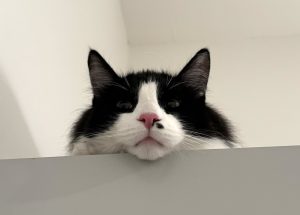69 Whiskers’ Swallowing Struggles: A Journey to a Purrfect Diagnosis
Rachel Kent; Emma Prybylski; and Anne Latuska
Whiskers’ Swallowing Struggles: A Journey to a Purrfect Diagnosis

Whiskers is having trouble swallowing. During this lesson you will explore dysphagia and learn about possible causes as to what can cause this. You will work through Whiskers’ to determine what is wrong.
Student Learning Objectives
- Define and identify the symptoms of dysphagia (trouble swallowing).
- Differentiate between dysphagia, regurgitation and vomiting
- Explain how how nerve damage, rabies, dental issues and foreign bodies can affect how a cat swallows food
Lesson
Dysphagia is the inability to properly swallow. There can be multiple causes, which will be discussed in detail, but the end result will be the same: the animal cannot swallow. This is distinct from regurgitation, when an animal’s food comes back out of its mouth before it has reached the stomach, and vomiting, in which an animal’s food has reached the stomach, then is expelled back out. So, if an animal is experiencing dysphagia, what comes out of its mouth will look very similar to the food it was just eating, as it has not experienced any kind of digestion. If an animal is regurgitating, the food will look more chewed and mushy, and they will appear to have slight effort getting the food up and out. If an animal is vomiting, their food will look like it has started the process of digestion, and they will have a lot of full body effort to get the food up and out.
Dysphagia can be caused by nerve issues, rabies, bad dental health, or a foreign body, which is when there is something stuck in the animal’s throat that they should not have eaten, like a toy. Explore these different causes below to get a better understanding of how dysphagia can occur and why.
Neurological Causes
Dysphagia can happen if the nerves that control swallowing don’t work properly. Nerves send signals from the brain to the muscles, telling them when and how to move. If these nerves are damaged or not working, the muscles in the throat can’t do their job, making swallowing very hard or even impossible.
Example: If a cat has a brain injury or a disease affecting its nerves, it might not be able to swallow food or water.
Rabies
Rabies is a serious disease caused by a virus that affects the nervous system of animals and humans. Animals with rabies often have trouble swallowing because the virus causes their throat muscles to stop working correctly. This is why you might see animals with rabies drooling a lot—they can’t swallow their saliva!
Fun Fact: Rabies can also make animals act strangely, like being overly aggressive or super calm. It’s a very dangerous disease that can be prevented with vaccines.
Dental Health
Bad dental health doesn’t just cause bad breath; it can also make it painful for animals to eat and swallow. If an animal has a sore tooth, gum disease, or even a broken tooth, it might avoid swallowing food because it hurts.
Example: A cat with a tooth infection might drop its food after trying to chew because it’s just too painful.
Foreign Body
Sometimes animals accidentally swallow things they shouldn’t, like toys, bones, or even pieces of string. If something gets stuck in their throat, it can block their ability to swallow and even make it hard to breathe.
Example: A curious kitten might chew on a piece of ribbon, and if it swallows it, the ribbon can get stuck in its throat. This is why it’s important to keep small objects out of reach of pets!
Why is this a problem?
When an animal is unable to swallow, this means that they are not able to consume any of the food they are attempting to eat. So, their body is not receiving any of the nutrients it needs and any of the nutrients that the food is providing. When their body doesn’t receive its vital nutrients, it doesn’t have the building blocks to do any of its other functions, like creating energy, storing nutrients, and running the entire complex system that is the body! So, this is a big problem.
What to do next?
If your cat has difficulty swallowing, you should avoid feeding them, check for any visible issues, and contact a veterinarian immediately. After taking your furry friend to the veterinarian and getting a diagnosis, follow the veterinarian’s treatment plan and watch for severe symptoms like trouble breathing.
Test out your knowledge by solving Whisker’s case!
Assessment
Further Exploration
For students interested in veterinary medicine, there are many engaging resources and activities to support their learning. Below are some examples!
Interactive Websites and Resources:
- Discovery Education Animal Science
- National Geographic Kids – Animal Health.
- The Humane Society’s Education Resources
All Images were created by the authors and are CC for NC
inability to properly swallow
the process of breaking down food into its nutrients for the body to use

